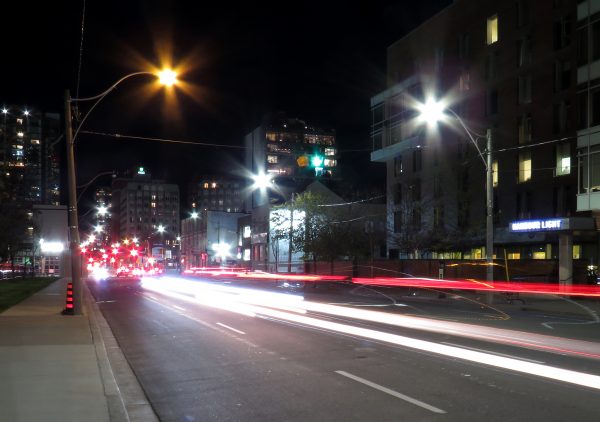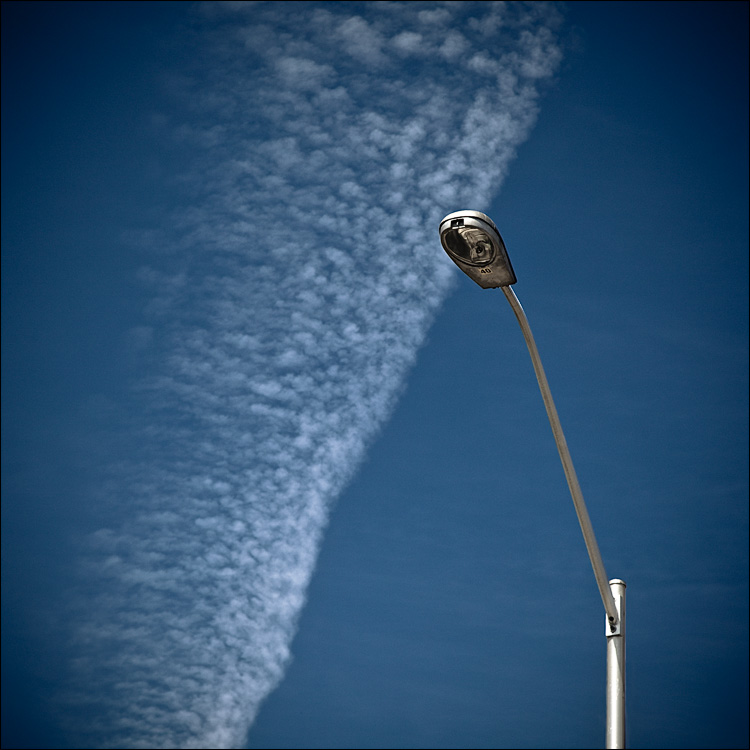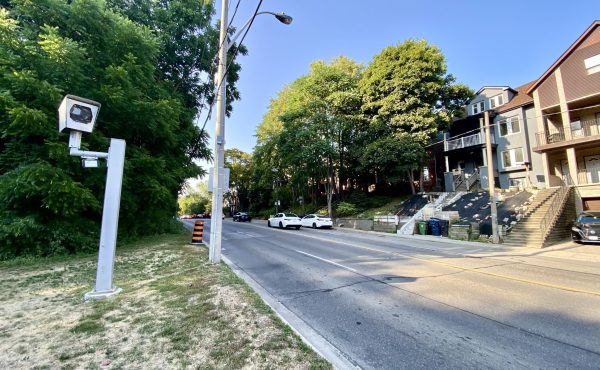Street lighting is an important, yet overlooked, part of any city’s standard infrastructure. For over seventy years, Toronto’s streets were lit with an elegant and increasingly unique streetlamp design. But modern standards and a desire for standardization will see this change, just as Toronto’s streetcars and street signs have.
Starting in 1949, the City of Toronto began to upgrade its street lighting to provide better illumination. Like many other cities and towns in Ontario, Toronto opted for bright, incandescent lamps in acorn-shaped luminaries. These were affixed to two-piece curved brackets that extended well over the roadway while providing a touch of elegance to an otherwise ubiquitous and mundane bit of civic infrastructure.
By the 1980s, municipalities were switching from incandescent lamps (which give off a white-yellow glow) and mercury-vapor lights (which give off a blue-white-glow) to high pressure sodium lamps (which give off an orange glow), which offered improved reliability and efficiency over older types. Elaborate brackets gave way to simpler, standardized streetlighting arms. The vast majority of streetlights outside the old City of Toronto are of this type.

In the late 1970s and 1980s, Toronto Hydro (which had responsibility for street lighting) began replacing some of its lights with standardized installations, but a public outcry forced officials to retain the classic light fixtures. Citizens preferred the gentle white glow over the harsher orange-beige lights installed elsewhere.
The City of Toronto bought the streetlights for $1 in 1989 to ensure the preservation of the classic type. Modern white-glowing metal halide lights — which retained the familiar acorn-shaped bulbs — replaced older incandescent lights. Along with street signs, the renewed lighting scheme helped to mark the old City of Toronto’s boundaries after amalgamation in 1998.
In 2005, Toronto Hydro bought back the City’s street lamps and poles for $60 million. Though the City, as Toronto Hydro’s customer and shareholder, is engaged in street lighting operational issues such as standards and fixture types, Hydro has sole responsibility for maintaining street lighting, managing its assets, and making any design decisions.
There are over 170,000 street lights in the City of Toronto maintained by Toronto Hydro, including the white-glowing acorn lamps, standard cobra head lamps, and vintage street lamps such as the globe lamps on Palmerston Boulevard, and the 1920s-vintage lamps on the Toronto Islands, which were recently replaced.
On my pandemic walks, I began noticing acorn streetlamps replaced with high pressure sodium (HPS) cobra head lamps (so-called due to their shape when seen from the top or bottom). HPS lamps give off a beige-orange glow, rather than the white shine of metal-halide or state-of-the-art light emitting diode (LED) lamps. Outside of Toronto, municipalities such as Mississauga, Brampton, and Markham have been upgrading their HPS lamps with LEDs, but so far, Toronto has been slow to adopt the new, energy-efficient technology.
I wrote to Toronto Hydro to find out what was going on. Hydro spokesperson Russell Baker responded, saying that the municipal corporation is “reactively – and temporarily – [replacing] acorn fixtures that passed its useful lifespan with cobra head fixtures.” The good news is that, according to Baker, “work is underway to approve an LED acorn fixture that meets our standard.” HPS lights affixed to older brackets would then be replaced with the new lamp.
Until then, Torontonians should expect to see more cobra heads above Toronto’s streets.
top photo by Wylie Poon / middle photo by Sean Marshall / bottom photo by Sam Javanrouh






7 comments
I love the neutral white light of the metal halide bulbs that you see on residential streets in the pre-amalgamation City of Toronto (and some busier streets like University Avenue). The colours of trees, grass, cars, and buildings look more natural in that light. It’s actually very close to the colour of daylight.
I find the metal halide bulbs to be less harsh and glaring than LED bulbs with a more natural and pleasant colour. I dislike the orange sodium vapour lights the most. Everything ends up looking orange and sterile.
The “acorn” head used with the metal halide lights is quite elegant as well. Perhaps LEDs could work similarly to metal halide bulbs, but they need more fine tuning in terms of colour and diffusion. They should also be designed to fit into the acorn fixtures rather than having this flat and utilitarian-looking bulb that doesn’t match the design.
Hopefully the new design will retain the elegance of the acorn design but also find a way to address light pollution by focusing the light downwards. It’s an issue not just relating to seeing the night sky, but also for people in mid-rise buildings near lights who get them shining directly in windows (as I learned living on a 3rd floor with one outside my window for several years).
The acorn fixtures that are in place today with MH lamps are not the same as the original ones used for incandescent bulbs. The reason is that the arc of the MH lamp is at a different position relative to the lamp base and this required a new design of the Fresnel lens that is built into the glass to provide light diffusion. Whether this change would be needed again for LED lamps within an acorn fixture depends on how the two sources compare. A little known aspect of the first conversion was that almost all of the original acorn heads were destroyed (over 20,000) because Ontario Hydro would not allow any “old inefficient” hardware to remain after the conversion. A few were rescued, and one of them provides beautiful soft illumination near my desk at night, needless to say with a much lower wattage bulb than during its street lighting days. Shhh! Don’t tell Hydro!
Any conversation about replacing streetlights with LEDs needs to include colour temperature and spectrum. Too much blue light is no good for people or animals at night, and too wide a spectrum is worse for light pollution. HPS is easily filtered out for astronomy since it produces such a narrow band of light, and it’s a pleasing-at-night warm temperature. Too often, LEDs are balanced with a cool blue daylight temperature, which is awful at night. See for example this article: https://www.cnn.com/2016/06/21/health/led-streetlights-ama/index.html
A great follow up Spacing article would be to see what the city is thinking, and make sure that it minimizes light pollution and impact on human and animal circadian rhythms.
Having been a member of a St Lawrence neighbourhood working group on streetlighting since about 2014 (when it was established by Pam McConnell) I can say that Toronto Hydro Streetlighting (THSL) say that they have been working on a new ‘palette’ of streetlights for many years. Both Councillors Wong-Tam and Cressy are now on – and organise – this group and at our last (pre-covid) meeting in 2019 THSL was not able to report on any real progress. I think 100% of the group agree that the current City’s listing (in the Streetscape Manual) of almost 100 streetlight types “approved by the City” is excessive but THSL seems to think it can be reduced to 3 or 4 (and they only seem to offer Cobras at the moment!). The City is NOT all the same and the design of streetlights (and their intensity and colour) should not be uniform. The City needs to sort out the log-jam with Hydro by getting senior City staff in Transportation, Urban Design (and probably finance) involved since at the end off the day money is involved! Senior politicians, (e.g. the Mayor) also need to get involved as the solution will cost $$. THSL is a City-owned entity, the City is their customer and the more ‘operational” City and THSL staff who have been dealing with this for 7 or 8 years seem unable to reach an agreement. Time for ACTION!
It’s time to fix the mess at City Hall and give Toronto beautiful & distinctive street lights.
I’m an architectural lighting designer. I have a few comments on this topic. If there are 170,000 poles in Toronto, the city could ask some of the local or Canadian lighting manufacturers to provide a prototype, retrofit with LED dark sky compliance of 3000K color temperature. 3000K is a little warmer than the current metal halide lamps. Would need type I, II, III and IV distribution and match the output with the existing fixtures. Or, like NYC, the city of Toronto can organize a design competition, designing a new Toronto city pole lighting, and collaboration with the manufacturers, which have the ability to develop the unique set of street lighting ( need experience with developing the reliable street light and pole then collaboration with the control manufacturer). Either way, the city of Toronto needs a big vision what kind of urban lighting they want. Now there are a lot of sophisticated lighting control options are also available (sustainability, ecological aspects are rather important now), so the lighting manufacturers need to work with the lighting control manufacturers.
I want the city to think big because Toronto is one of the fastest growing cities in North America.